Steamy Java 2012 Blog
Diesel Tour Part 1
Updated 9 August
Steamy Java 2012
DVD (Details Later) |
Bernd's Diesel Tour is planned to provide:
17 July - Transfer to the airport and flight probably with
Garuda GA 292 11.20 – 12.50 hrs to Malang, charter bus
to the sugar mill Kebonagung with eight Schöma and three O&K
diesel locos. According to unconfirmed
information the mill stopped using their railway, so in the afternoon
we’ll continue to the active system of
Krebet Baru. Probably hotel Pelangi Klojen in Malang.
Fellow participant John Browning is blogging this trip and his own prelude. You can follow him here. Also blogging is tour leader Bernd Seiler. His blog is here.
There's not much time for mill visiting on this first day but what we find will appear hear. As the pattern for this report, expect to see Bernd's pre-tour plan for the day plus what we actually saw and did. I'll try to keep the plan and the actual in different type faces.
We left the hotel around 2 pm and met up with John and Scott at Kebonagung for our first mill. Apart from one loco plinthed on the main road, all of the locos are confined to depot and the area outside and are slowly getting covered in stored wood and metal. The mill is being redeveloped and the locos are not the only things being saved and stored but for what future?

The depot is full of out of use steam and diesel and other stuff.

Two steam locos are outside the depot (5 & 4).
We moved on to the field line at Krebet Baru but trains had finished for the day and they were loading cane on the main line for a morning train. At the collecting station, we found 2 diesels stabled and one 'draisine' which was pushed out for us to photograph.


This Diema track car is used for track repair and derailments
And that was it for the shortest day for mill visiting so far. Normal service will resume tomorrow.
The next few days are:
18 July - Full day visit to the mill at Krebet Baru with
almost 30 diesel locos, among them three Motorail, a Diema
and an O&K, the rest are from Schöma. The mill still operates
a field line and is hence especially
interesting to us. Hotel in Malang.
The day started cloudy and quickly turned to light rain. The rest of the day was a mixture of cloud and rain sometimes heavy with no sun at all. Despite that, the diesel action at Krebet Baru was excellent and I'm sure everyone got good shots and video. The day really started from the Gondanglegi 'emplasment' around 8 am and we chased 3 trains (2 cane trains with an empty ash train in between) back to the mill. We found several additional positions to those I had been shown on the first day.
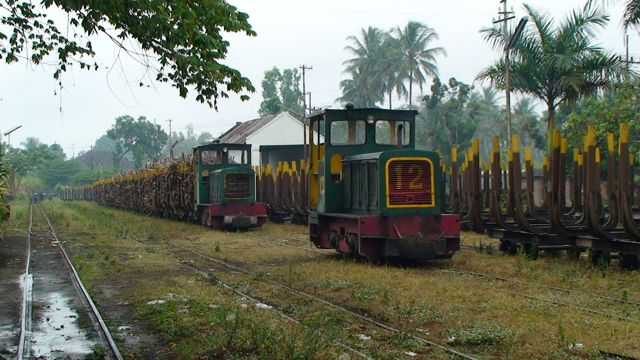
Gondanglegi first thing in the morning
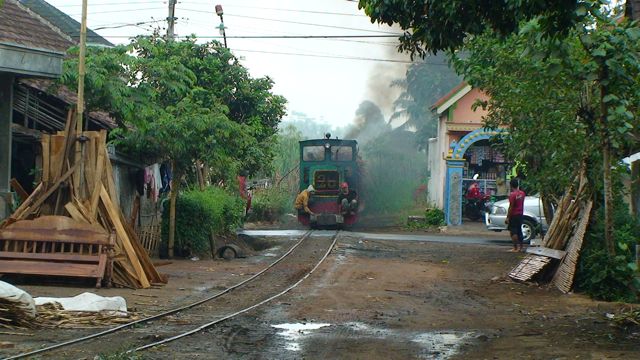
The first loaded train at a road crossing before the climb
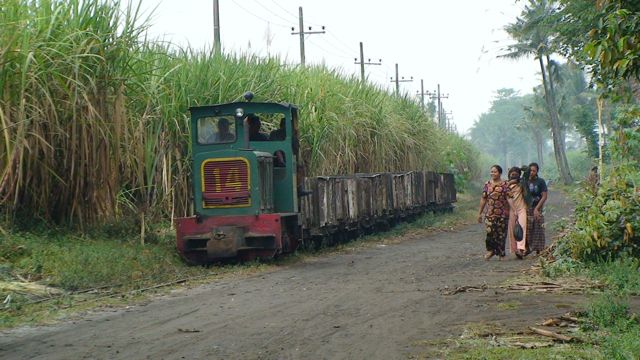
The empty ash train on the long parallel road-rail section after the climb
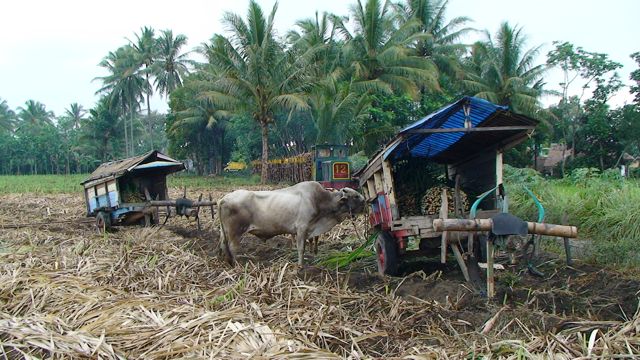
The second cane train bringing up the rear of the convoy beyond the parallel road-rail section
We had a depot visit before lunch and in the afternoon explored further beyond Gondanglegi finding one cane train heading there. The rain got heavy at this point and we elected to head to Krebet Baru back chasing what we were told would be 1 train but which turned out to be 5 trains in convoy with the 4th train banked. In the rain, only 3 of us were out there to see the full thrash up the hill but it was something to be enjoyed.
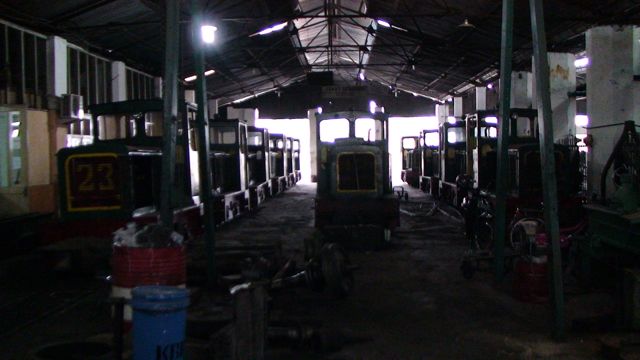
12 almost identical Schoema locos lined up in the running shed at shift change

Beyond Gondanglegi, No. 17 brings cane from the fields of Gunung Bandar
The 5th train was somewhat behind the rest after allowing the banker off the 4th train to drop off into a siding. So, having seen that we struggled to catch up with the others on the way to the mill. We found the 5th train stopped with a derailment, the 4th also stopped with a derailment and the 3rd stopped for the crew to drink coffee. The first 2 trains had already got beyond the end of the parallel road and rail section by the time we reached the end. We waited but only the 3rd train came. The others were still sorting out their derailments. So around 5 pm, with light fading rapidly, we headed back to the hotel. The photos should give some idea of the potential of this line. It would be good to come back with more time to give extra days to get better weather and to explore and understand it further. But will it survive if they are taking of 2 more seasons before the stop the lines to the fields. Definitely one of the best (diesel) mills for quantity and variety of daytime line work.
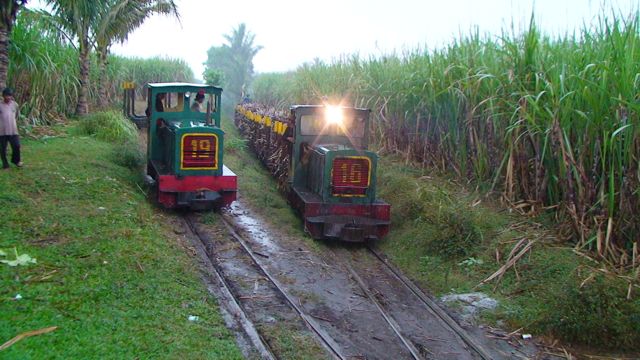
The fifth train passes the banker of the fourth train on the climb as the rain eases. I should have great video here but I haven't yet checked to see if it will give any better stills.
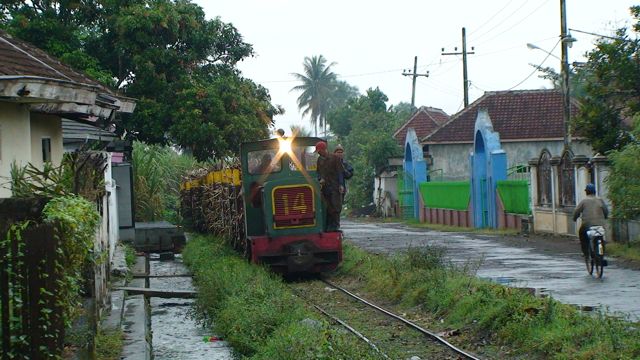
With the ditch full of water from the rain and headlight on because of the fading light, the third train in the convey is about to leave the parallel road-rail section
19 July - In the morning we’ll continue to Kedawung.
The field line of this mill still uses a level crossing with the
state railway. Besides three Japanese locomotives they own seven Schöma
and Java’s only known
Baguley. Their former steam fleet of seven locomotives is dumped in the
depot. Hotel in Pooling.
We had a swift transfer to Kedawung (2 hours from Malang) but the weather improved only slightly (no raid). There were field trains in 3 directions and we saw cutting to the east, the ash/empty lori train returning from the south west and the two locos working to the north return for their lunch break near the flat crossing with the national railway. This makes Kedawung a reasonable mill for field work and although the distances from the mill weren't great, this can change as the season progresses and a considerable mileage of track is still usable/used.

Japanese built loco No. 3 brings the empty ash wagons back to the mill from the south west. Earlier, it took out a mix of ash wagons and empty cane wagons.
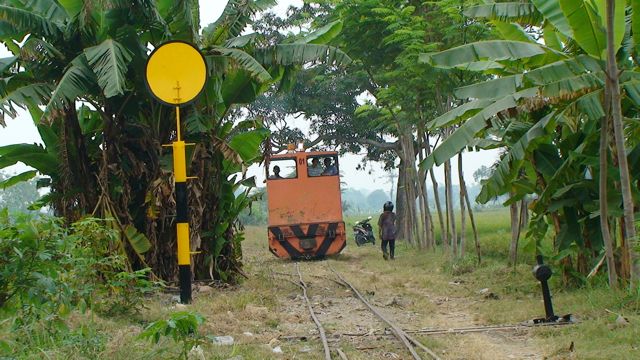
Another Japanese loco approaches the disk signal close to the flat crossing with the national railway to the north of the mill.

The crews are off to lunch or possibly shift change. By parking here, they avoid an extra crossing of the national railway and the busy north coast road. In the early evening but most likely after dark, they will haul cane back to the mill.
We had time for a late afternoon visit to Gending where we established that two lines have field work at the moment. We observed cane being hauled from the truck yard and shunting in the mill before bad light stopped play. And so to the Hotel Ratna, Pooling for the night.

Showing locos from 3 different builders (Diema, Keio and Schoema) and also the signal box and covered weighbridge, this is a classic Gending yard scene.
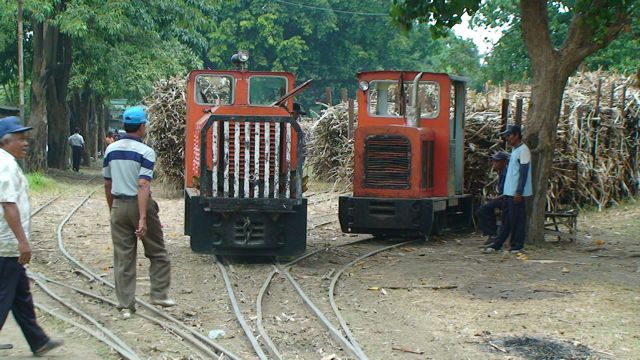
A Schoema (left) and Diema (right) - if I have that correct - shunt the yard
20 July - After a brief visit to Wonolongan where only two
Japanese locomotives and maybe one Schöma will be
in use we’ll head for Gending. Here we’ll see three Diema,
two Schöma and two Japanese locos. The
afternoon we’ll spend in the sugar mill of Prajakan. Besides two
Japanese locos they have two Schöma
and one O&K. Hotel in Pooling.
We were at Wonolangan just after 7 in good light thinking we should have come earlier but the office doesn't open until 7 anyway. We saw the 3 active locos and the dumped steam and also paid our respects at the mausoleum of the Etty family from Britain who once owned the mill. Their gravestones tell the story of the Empire and how in those days Brits were spread all round the world and many died 'in post'.

Loco No. 5 was in charge of empty lori from the unloading gantry back to the loading point.

Japanese loco D VI has a rear bunker like a steam loco probably to protect the cab when shunting cane backwards.
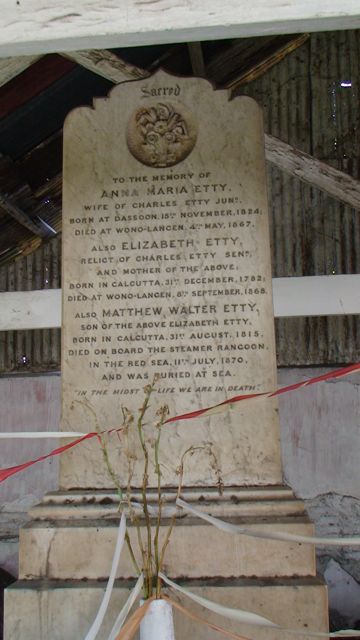
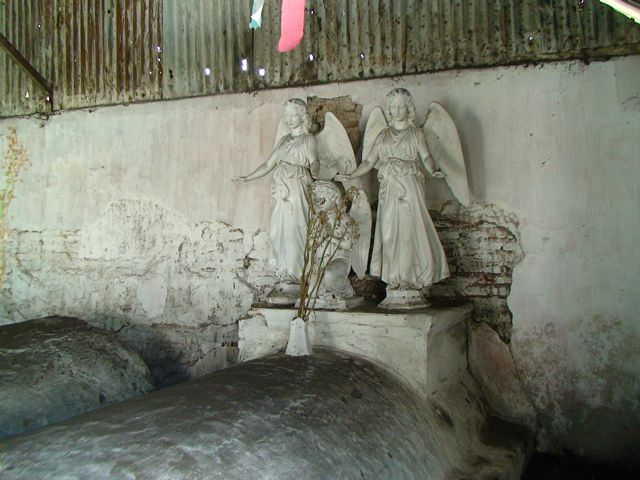
We then went back to Gending and found a train returning with temporary track from the east and this track was then taken to the west with a load of empties. Two field lines in use at Gending, making it the best mill in the area as neither Wonolangan nor Pajarakan have any field work left.

Gending No. 1 (Schoema 3000 of 1968) brings temporary track back to the mill from the east.
At Pajarakan, the mill was not working so they were unloading cane trucks into rail lori to release the trucks. We saw their home-made loco No. 04 along with 2 Japanese diesels and a Schoema.
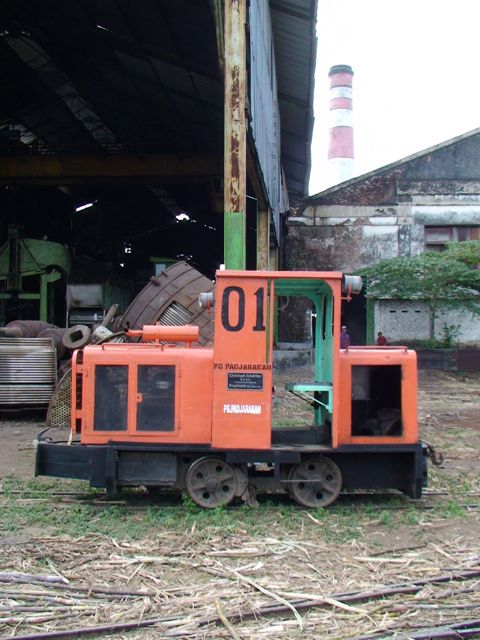
Schoema 01 with the mill chimney behind.
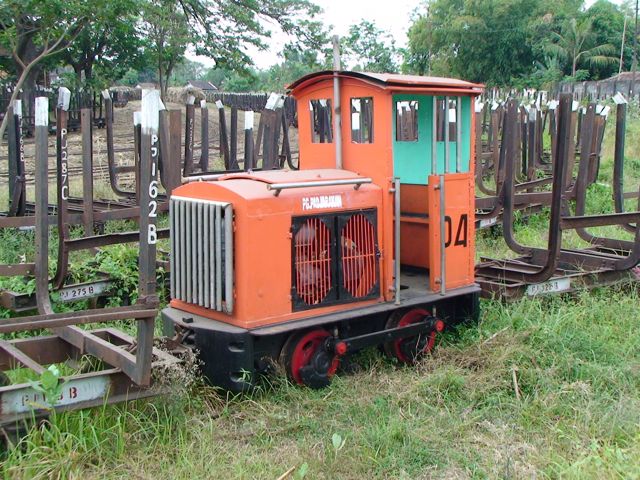
Apparently home-made from spare parts, No. 04 has a Deutz engine.
And finally back to Gending where the trains from the field were due to run after 5 pm (yesterday they were back by 3 pm). We made a few shots in the yard before retiring.
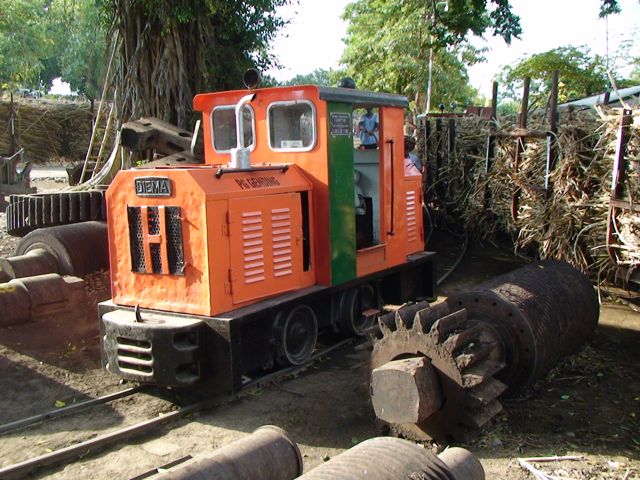
Most mills have a dump of old milling parts, and here is the one at Gending with loco Diema loco No. 5.
21 July - In the morning we’ll go to Jatiroto, the
mill with the largest network on Java (almost 200 miles). Here
we’ll find the tiny Schöma-locomotives which are doing the
job of the water buffalos on other systems.
They collect the loaded sugar cane wagons on temporary tracks and haul
them to the main line. On the
main line a large fleet of very similar looking Japanese diesels will
haul the, sometimes impressively long
trains to the sugar mill. In the mill one can still find a number of dumped
steam locomotives, among them
many Mallets. In the evening we’ll continue to our hotel in Jember.
This was a good day for still photography but probably not a very good day for video. It was also a day when we succeeded in the loco depot and yard and did less well in the fields. Jatiroto has had far fewer visitors than Semboro in recent years as all of the steam locos are dumped. To do the field lines properly would require a train or railcar charter (they only have 2 working railcars at the moment) or the use of motorcycles (it seems). The mill lines cross a major canal and the main Probolinggo - Jember road at 3 places (2 in use currently with one more with track still in place) and we focused on these lines although perhaps lines south from the mill have better road access. We did see a light engine with its auxiliary wagon and a loco and around 70 empty cane wagons cross the canal bridge closest to the mill but afternoon attempts at early field trains back to the mill ended in failure when the loco was sent back to collect some more wagons.

Loco and auxiliary wagon head for Semeru volcano
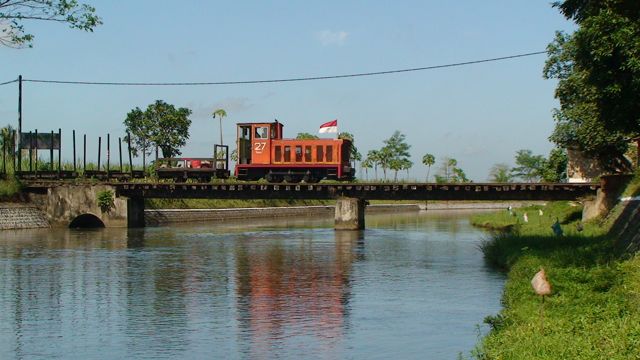
No. 27 (Hokuriku) complete with Indonesian flag crosses the canal with empty wagons.
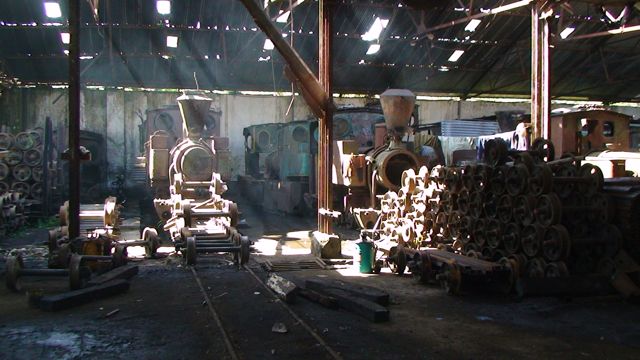
View inside the steam loco depot.

Another view of this shed full of dumped locos.

This steam roller is preserved at the loco shed area. No identifying numbers were found.
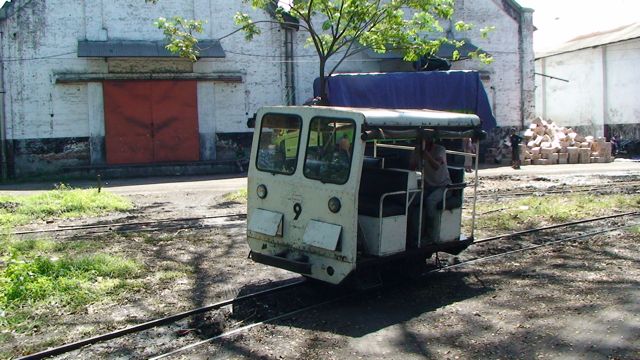
Several rail cars are in use - No. 9, seen here, plus No. 1 as well as 2 others used by the PW crews.
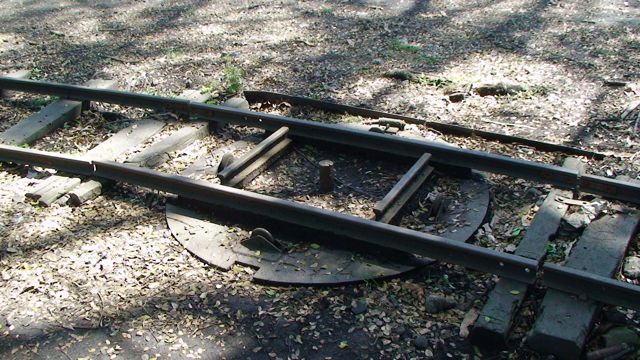
Turntable for the rail cars at the depot.

No. 35 (Hokuriku) on the bagged sugar train.

One of the two 3ft 6in locos slowly disappearing in the undergrowth.
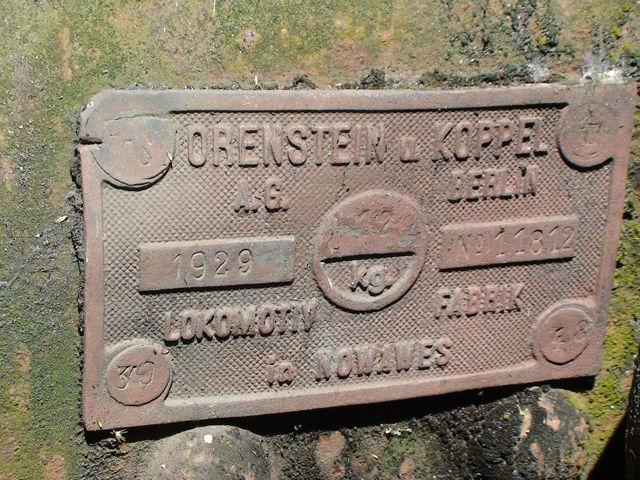
Boiler plate from the other 3ft 6in gauge loco. Both were 0-4-0T, I believe.
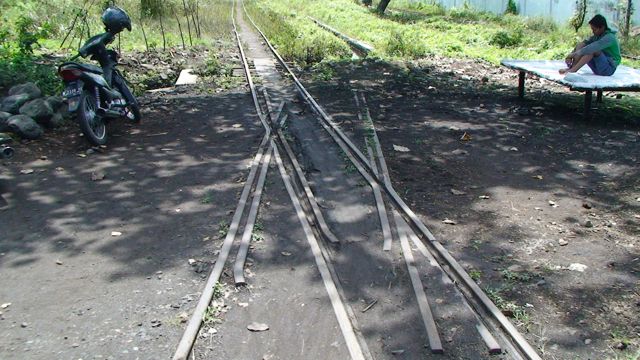
Remnants of the 3ft 6in track - crossing the mill 700mm gauge.
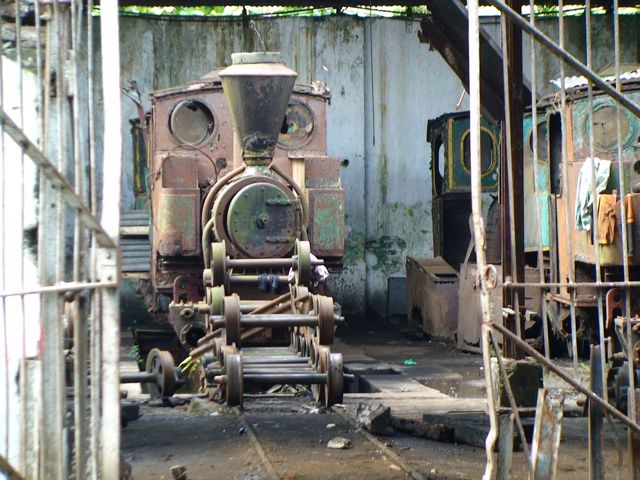
Afternoon view into the steam shed.
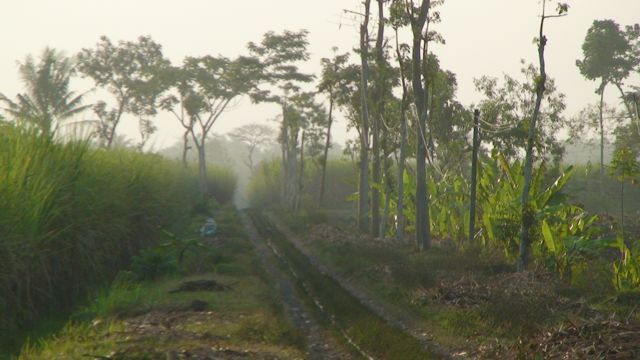
Had the loco not been sent back to collect more full wagons, this shot would have included a cane train.
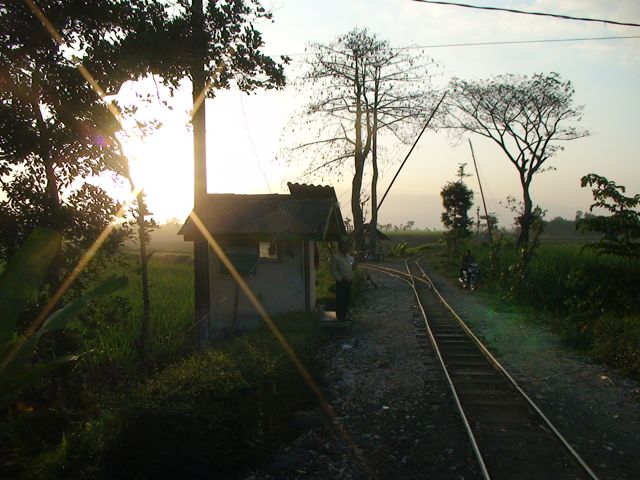
The lighting was very nice for the train that did not come!
The rest of the diesel tour will be on a different page. From 22 July, click here for more.
You can contact me at john@linesiding.co.uk